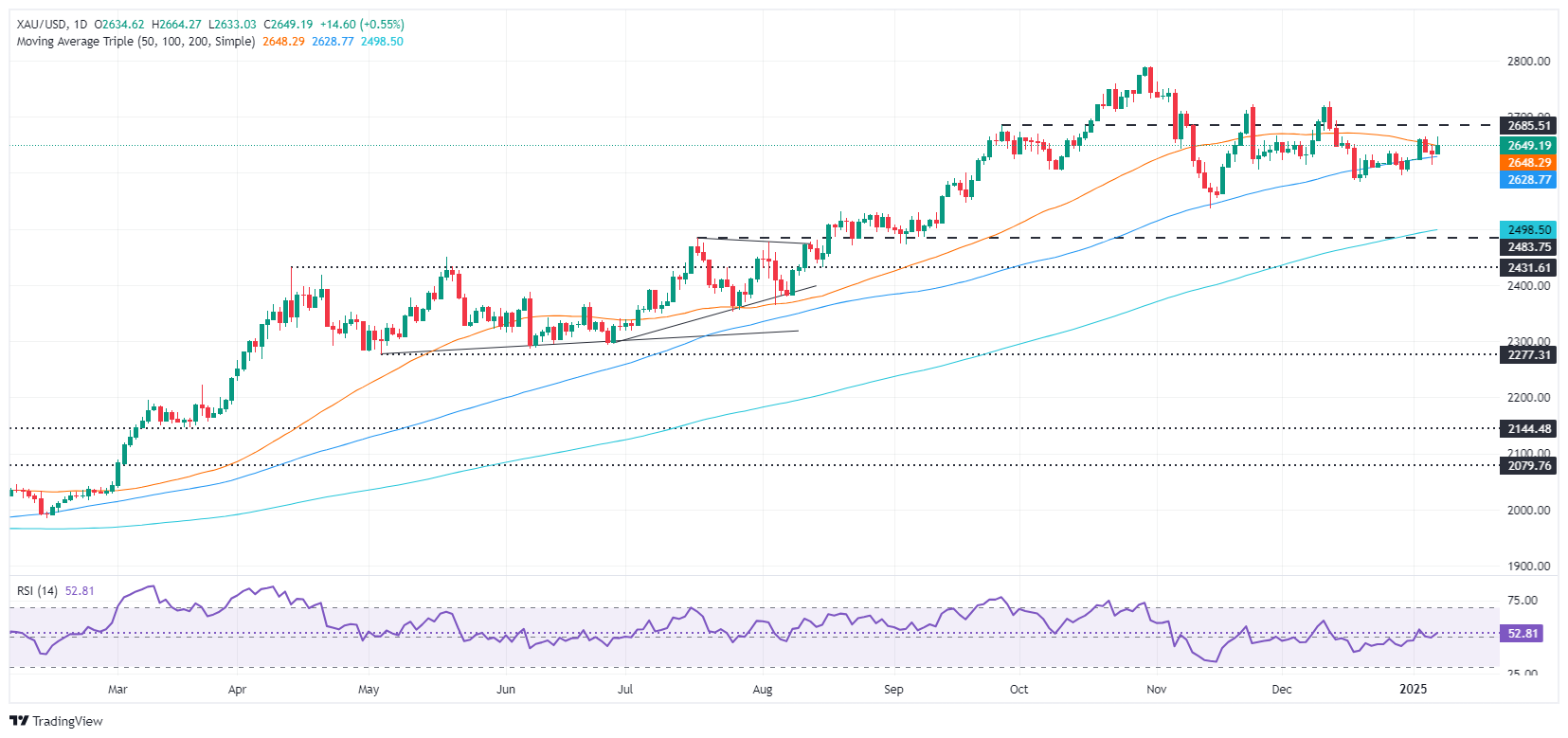- Gold rises to $2,664 but faces pressure from a strong US labor market and Trump’s assertive tariff plans.
- Trump’s unexpected statements about taking back the Panama Canal and imposing tariffs on neighbors boost the US dollar.
- The People’s Bank of China increases gold reserves, signaling increased demand as global economic uncertainties persist.
The price of gold advanced at the end of the North American session on Tuesday, but retreated from daily highs due to strong economic data from the United States (US) and comments from President-elect Donald Trump at his press conference. XAU/USD is trading at $2,648, with a gain of 0.50%.
In the United States, the calendar revealed a strong employment report amid an increase in job openings, reassuring investors that the labor market is strong. Additionally, business activity in the services sector improved markedly, weighing on expectations of further easing by the Federal Reserve (Fed).
Meanwhile, US President-elect Donald Trump crossed lines and said he would like to regain control of the Panama Canal and reiterated that he would impose tariffs on Canada and Mexico. This boosted the US Dollar (USD) and limited gold’s advance.
Earlier, the bullion rose to a two-day high of $2,664 after China’s central bank increased its gold reserves for the second consecutive month by 300,000 ounces to 73.3 million, an indication that the People’s Bank of China ( PBoC) resumed its purchases after a six-month pause.
US Treasury yields remained high, strengthening the Dollar. According to the federal funds rate futures contract at the Chicago Board of Trade (CBOT), investors estimate either a 51 basis point (bp) easing or two 25 bp interest rate cuts by the Fed towards the end of the year.
For this week, the US economic agenda will include the ADP employment change report, initial jobless claims figures, minutes from the latest Fed meeting and the December nonfarm payrolls report from USA
Daily Market Summary: Gold Price Rises Amid High US Yields, Underpinned by PBoC Buying
- Gold remains pressured as US real yields rise two bps to 2.28%.
- The US 10-year bond yield rises six and a half basis points to 4.691%.
- The US Dollar Index (DXY), which tracks the performance of the dollar against a basket of six currencies, is up 0.26% at 108.55 after bouncing from a weekly low of 107.75.
- The ISM services PMI in December rose to 54.1, beating forecasts of 53.3 and November’s reading of 52.1.
- The Job Openings and Labor Turnover (JOLTS) report revealed that job openings increased from 7,839 million to 8,098 million in November.
- The US trade deficit widened in November, according to the US BEA, reaching $78.2 billion compared to $73.6 billion in October.
- Imports rose 3.4% mom to $351.6 billion from $339.9 billion, while exports rose 2.7% mom to $273.4 billion from $266.3 billion.
XAU/USD Technical Outlook: Gold price advances but remains below $2,650
Gold prices have advanced above $2,640, opening the door to trading around the $2,640 – $2,650 range. However, the yellow metal cannot decisively surpass the 50-day SMA around $2,651, which could pave the way for further upside.
In that case, the next resistance level would be $2,700 before challenging the December 12 peak at $2,726. If broken, the next stop would be the all-time high at $2,790.
Conversely, if sellers drag XAU/USD below the 100-day SMA of $2,627, look for a test of $2,500 before gold extends its losses to the 200-day SMA of $2,494.
Gold FAQs
Gold has played a fundamental role in human history, as it has been widely used as a store of value and medium of exchange. Today, apart from its brilliance and use for jewelry, the precious metal is considered a safe-haven asset, meaning it is considered a good investment in turbulent times. Gold is also considered a hedge against inflation and currency depreciation, since it does not depend on any specific issuer or government.
Central banks are the largest holders of Gold. In their aim to support their currencies in turbulent times, central banks tend to diversify their reserves and purchase Gold to improve the perception of strength of the economy and currency. High Gold reserves can be a source of confidence for the solvency of a country. Central banks added 1,136 tons of gold worth about $70 billion to their reserves in 2022, according to data from the World Gold Council. This is the largest annual purchase since records exist. Central banks in emerging economies such as China, India and Türkiye are rapidly increasing their gold reserves.
Gold has an inverse correlation with the US Dollar and US Treasuries, which are the main reserve and safe haven assets. When the Dollar depreciates, the price of Gold tends to rise, allowing investors and central banks to diversify their assets in turbulent times. Gold is also inversely correlated with risk assets. A rally in the stock market tends to weaken the price of Gold, while sell-offs in riskier markets tend to favor the precious metal.
The price of Gold can move due to a wide range of factors. Geopolitical instability or fear of a deep recession can cause the price of Gold to rise rapidly due to its status as a safe haven asset. As a non-yielding asset, the price of Gold tends to rise when interest rates fall, while rising money prices tend to weigh down the yellow metal. Still, most of the moves depend on how the US Dollar (USD) performs, as the asset is traded in dollars (XAU/USD). A strong Dollar tends to keep the price of Gold in check, while a weaker Dollar is likely to push up Gold prices.
Source: Fx Street
I am Joshua Winder, a senior-level journalist and editor at World Stock Market. I specialize in covering news related to the stock market and economic trends. With more than 8 years of experience in this field, I have become an expert in financial reporting.








